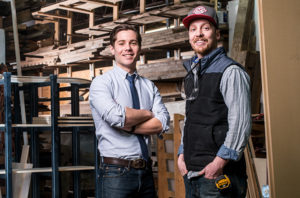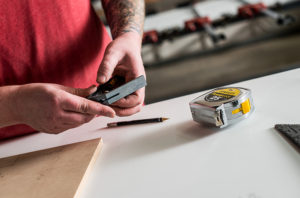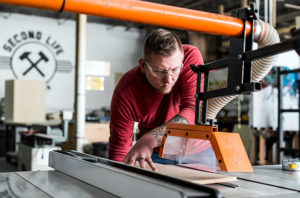Second Life’s design and fabrication expertise turns vision to creative reality.
Second Life Studios could easily be divided into two separate areas inside its offices: fabrication and design. Or the shop vs. the desk jockeys.
That will never happen. The small firm has carved out a niche by avoiding such division and creating a team of skilled employees who work together to push the limits and to generate fresh ideas for customers. Their interior designs have set the tone for several local bars and restaurants, and the business is gaining momentum on a national level.
Second Life Studios designs and builds the interior of public gathering spaces, ranging from high-end bars and restaurants to boutique or five-star hotels. Creative director Chris Gorney, one of four owners, calls the firm a high-hospitality architectural fabrication company.
“We are a fabrication company run by creatives,” Gorney said.
That’s a key description because it allows the Kansas City firm to stand out from others who might specialize in design but don’t understand fabrication. Second Life uses design definitively to set a business apart from its competitors. The small but mighty firm of 20 full-time employees has a strong relationship with many national hotels and restaurants.
In Kansas City, its presence stands out. It’s hard to miss the intricate design details at the Crossroads bar and restaurant Rockhill Grille. The firm’s fabrication work there and at places like the Summit Grill turn the bar design into artwork that creates the tone for the entire space.
Second Life’s work was on the national stage this winter when the interactive secret agent restaurant called SafeHouse opened to considerable media fanfare in Chicago. Second Life helped design many of the restaurant’s interactive twists that entertain guests. It includes hidden doors, a glass dance floor and the featured “cone of silence” table, which is modeled after the Get Smart comedy show.
There are many other unique contraptions and gags that Gorney can’t disclose without ruining the experience. Designers laid out their wildest ideas on paper and left it to the Second Life team to make the dreams a reality.
The firm has fabricated the impressive wood wine racks at Underdog Wine, which create a much different experience from the typical liquor store. Second Life also created the elegant bars within the Kauffman Center for the Performing Arts and worked on the store design at Charlie Hustle’s Plaza location.
Innovative Vision
Even more impressive, Second Life designed and fabricated the eye-catching Ocean & Sea nautical pop-up clothing shop that doubles as a pull-behind mobile trailer with storage. It’s an example that the company’s success locally and nationally isn’t just luck. The expertise is there to meet the challenges.
When Brendan O’Shaughnessy, owner of Ocean & Sea, wanted to grow his apparel business, he sat down with Gorney to talk about a mobile pop-up shop. O’Shaughnessy wasn’t sure where to start. Gorney knew exactly what to do.
“He’s rea lly good at casting vision and that’s his role in the company,” O’Shaughnessy said. “It’s up to others to actually execute these crazy ideas he comes up with.”
lly good at casting vision and that’s his role in the company,” O’Shaughnessy said. “It’s up to others to actually execute these crazy ideas he comes up with.”
Gorney felt the unusual Ocean & Sea concept—a nautical branded company based in landlocked Kansas City—must play a role. He suggested playing off the company’s quirky branding by crafting a wind wagon, sometimes called a sailboat wagon. The idea evoked an image of the 1800s when settlers in Kansas territory hoisted sails to wheeled-trailers to move with wind power.
Gorney accomplished that innovation by building a sailboat atop a 30-foot long and 8.5 foot wide trailer that could be pulled behind the company van. The pop-up shop would have room for storage—and it would be impossible for customers to miss.
“As soon as I heard him say it out loud, I knew right then and there I was going to do it,” O’Shaughnessy said. “The idea of a vessel being pushed on wheels on land was the perfect correlation.”
O’Shaughnessy knew it was what he needed to build on his brand and to stand out from competitors. When Gorney first proposed the goofy idea, O’Shaughnessy had only a few key competitors. Just a few years later, he has about 30 apparel and print competitors. The pop-up shop provides a uniqueness to Ocean & Sea. That’s what Second Life strives to do for every client.
Esprit de Corps on Display
A recent tour of Second Life Studios provided a meaningful glimpse into the company’s success. Designer Siegfried Flores leaves his office to show off the cavernous shop. Flores talks comfortably as a mill saw hums in the woodshop and welders meld steel in the metal shop.
He points to meticulous piles of century-old reclaimed wood, piles of castors and carefully- placed clamps that sit at the ready for the next project. Inside the metal shop he calls attention to a steel structure that will become the mobile back bar for the Rockhill Grille’s new event space. He and the welders show off another piece that is headed to Chicago soon.
Flores emphasizes that the Second Life team is anything but cloistered in their respective work areas. They all work together and think creatively. The esprit de corps was on full display in January when an employee stopped a Saturday shipment just as it should have been on a truck headed to Chicago to meet an urgent deadline.
“It was actually done and it was built how we designed it,” Gorney said. “But our shop fabrication designer said we needed to take one more look at it, and they changed a few small things and added a few small things just to make it stronger.”
They missed the truck, but that was no problem for Second Life and its creative team. They rented a box truck and two employees canceled their weekend plans, jumped in the truck cab and embarked on a lively road trip that is sure to go down in Second Life Studios lore. They were back to work by Monday, sharing the adventure.
“It was just one piece, but it was really important,” Gorney said. “Better to delay and deliver quality than to rush and
not deliver what you say.”
Gorney said it is a classi c reminder that the Second Life Studios staff is the essential ingredient to maintaining impeccable quality. Their effort allows the company to not only hit the bottom line, but also to grow. Gorney, a constant learner, said he strives to get out of the way and let the staff do their job.
c reminder that the Second Life Studios staff is the essential ingredient to maintaining impeccable quality. Their effort allows the company to not only hit the bottom line, but also to grow. Gorney, a constant learner, said he strives to get out of the way and let the staff do their job.
“If you hire people who can achieve at a high level, then the owner’s job is to support them,” he said. “To just clear a path for them and let them roll.”
The team was not assembled haphazardly. The firm has hired employees strategically not only for their skills, but also because they match the culture at Second Life Studios.
“The wrong employee can be really toxic,” Gorney said. “You need people who are on board for the mission of the company. You need those who are on board for the vision of the company.”
Gorney said the firm must have people who want to dig
in and get their hands dirty.
“You need people who are willing to get on the boat and help row. We don’t need someone standing at the back of the room telling us how to row better,” he said. “We need people who are willing to help us fix it as we go. And that’s everyone who is here.”
Designing the Future
Gorney knows many are dismissive of having even one business partner, let alone a team of four owners. But he said Second Life has been so successful because the four of them have different skills and expertise and don’t get caught up in egos. Gorney is the creative director, while co-owner Mitch Trumpp is fabrication director. Barry Lakey is the managing director, and Dylan Tucker is the chief financial officer. They all know their strengths, Gorney said.
Some of the owners have an entrepreneurial spirit in their blood. Gorney’s great-grandfather owned a masonry company that he passed down to his grandfather. His father owned an investment firm, and his mom owned an interior design business. Trumpp and his brother started a woodworking company.
Tucker and Lakey both had a natural entrepreneurial spirit that has helped shape the business. Some of the entrepreneurs collaborated as contractors on projects before taking the leap together to open Second Life Studios. “Without these three guys, I think none of us would want to do this anymore,” Gorney said.
Each brings a unique background to Second Life, including Trumpp’s work as a Christian missionary and Gorney’s work in disaster relief and travel. Their work before Second Life adds a unique artistic feel and a utilitarian aspect to their design.
That spirit has served the firm well so far during its growth. The revenue grew 200 percent from 2015 to 2016 and they’re on track to do the same in 2017.
To reach those goals, they’re focused on the national market, which already represents their biggest growth area. The firm hit a major milestone this year when it hired the first employee not based in Kansas City. The project developer will work out of Chicago, conducting sales for Second Life. It’s a big step for a firm that had an office staff of two just three years ago.
The business is also moving to a larger space at Roanoke and 32nd Street in Kansas City later this year. It’s the third move in four years. Gorney said the space is large enough to account for growth and to help secure their future.
Culture Changes
While every small business must think constantly about the bottom line, the owners at Second Life Studios must also consider how to maintain the firm’s culture and identity as they continue to expand and add employees.
“One of the biggest advantages we have is that our shop and design team know each other,” Gorney said.
The shop—skilled wood workers and welders and other highly trained professionals—can sit down and easily hammer out plans with the firm’s designers. It happens organically, he said, because they’ve chosen wisely when hiring each employee. Sometimes that connection is lost at similar firms where each person is caught up in his or her own world. Second Life Studios has avoided that in part because the owners are part of each workforce where there could be division.
That teamwork is responsible for the high-quality work and customer service that has driven sales. As they grow, Gorney said, the owners will have to double-down on their hiring process.
“The larger we get, the harder it is to care for clients on the level that we want to,” he said. “I heard someone say that the larger you get, the smaller you have to act.”
Gorney knows Second Life can accomplish this by using some of the same precision that they’ve utilized to get where they are now. No matter how large they grow, Gorney said the mission and focus of Second Life Studios will remain the same.
“Our goal is to work with other people in the design-and-build world to help make their ideas come to life,” he said.

